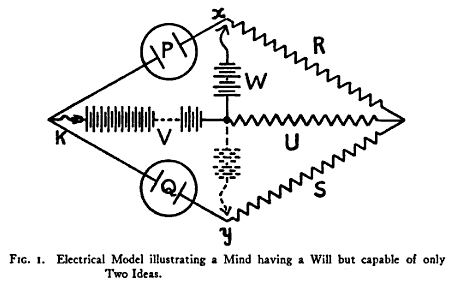‘An important feature of a learning machine is that its teacher will often be very largely ignorant of quite what is going on inside, although he may still be able to some extent to predict his pupil’s behaviour.’
Alan Turing, Computing Machinery and Intelligence (1950)
Replenishing each worn-out piece of its glimmering hull, one by one, the day arrives when the entire ship of Argo has been displaced – each of its parts now distinct from those of the ‘original’ vessel. For Roland Barthes, this myth exposes two modest activities:
- Substitution (one part replaces another, as in a paradigm)
- Nomination (the name is in no way linked to the stability of the parts) 1
In an esoteric paper, published in 1930, Lewis Richardson teased out an analogy between flashes of human insight and the spark that leaps across a stop gap in an electrical circuit. The paper, entitled
The Analogy Between Mental Images and Sparks, navigates around a provocative sketch stencilled into its pages of a simple indeterminate circuit, whose future state it is impossible to predict. Richardson’s playful label for the diagram hides a deep significance. For even at the simplest binary level, Richardson argued, computation need not necessarily be deterministic.

The discrete breaches the continuous in the act of nomination. Take for instance the spectrum of colours, the extension of which ‘is verbally reduced to a series of discontinuous terms’ 2 such as red, green, lilac or puce. Each colour has no cause but its name. By being isolated in language the colour ‘blue’ is allowed to exist, but its existence is an act of linguistic and, some would argue, perceptual severance. The city of Hull, the phrase “I will”, the surface of an ice cube and an image compression algorithm are entities each sustained by the same nominative disclosure: a paradox of things that seem to flow into one another with liquid potential, but things, nonetheless, limited by their constant, necessary re-iteration in language. There is no thing more contradictory in this regard than the human subject, a figure Barthes’ tried to paradoxically side-step in his playful autobiography. Like the ship of Argo, human experience has exchangeable parts, but at its core, such was Barthes’ intention, ‘the subject, unreconciled, demands that language represent the continuity of desire.’ 3
The discrete and the continuous are here again blurred by analogy. Electricity flowing and electricity not flowing: a binary imposition responsible for the entire history of information technology.
1 Roland Barthes, Roland Barthes (University of California Press, 1994), 46.
2 Roland Barthes, Elements of Semiology (Hill and Wang, 1977), 64.
3 Paul John Eakin, Touching the World: Reference in Autobiography (Princeton University Press, 1992), 16.
